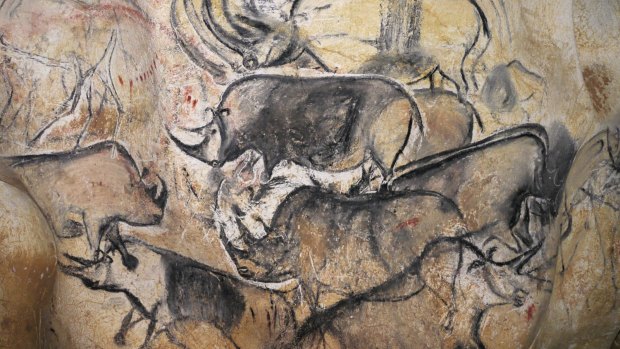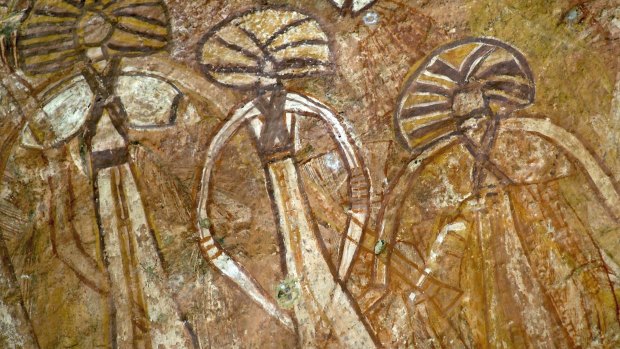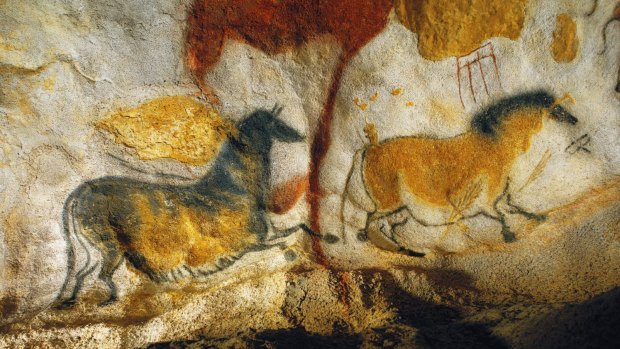This was published 4 years ago
Ten amazing rock art and cave paintings worth seeing

Rock art in Chauvet Cave in France.Credit: French Ministry of Culture and Communication
CHAUVET CAVE, FRANCE
This cave was only discovered in 1994 and contains Europe's oldest cave paintings, thought to date back more than 30,000 years. Scenes painted in either red or black depict lions, bison, rhinos and mammoths, as well as a seven-metre parade of galloping horses. The delicate original is closed to tourists, but a full-size replica is superb, while an adjacent high-tech museum brings the prehistoric era to life. See grottechauvet2ardeche.com
LEANG-LEANG CAVES, INDONESIA

Rock art at Burrunggui in Kakadu National Park.Credit: Peter Eve/NT Tourism
Southeast Asia has abundant, often overlooked cave art, yet it's some of the world's oldest, and the oldest yet found to depict animals. This site in southern Sulawesi, however, features the earliest hand stencils anywhere, estimated to be nearly 40,000 years old and overturning theories that cave art first appeared in Europe. Nearby caves can be visited with a guide and depict native creatures such as boar and pig-deer. See indonesia.travel
CAVE OF SWIMMERS, EGYPT
There is some debate over whether the floating human figures on these Saharan caves in southwest Egypt depict swimmers, but no matter. Whatever they're doing – and even if they're some kind of spirits – they look distinctively human. They're joined by giraffes, dogs and goats. Since the caves were popularised by the movie The English Patient this 10,000-year-old art has sadly become rather degraded and graffitied. See egypt.travel

Horses in the Lascaux II caves in France.Credit: Dordogne-Perigord Tourisme
ALTAMIRA CAVE, SPAIN
Galleries of deer, bison and horses wander across the various galleries of this cave system in Spain's Cantabria region, with curves in the rock cleverly used to providing a striking three-dimensional effect, and colours startlingly fresh looking. The paintings are at least 14,000 years old. Visits are highly restricted, but you can also see an exact reproduction and interesting museum on Palaeolithic life and prehistoric archaeology. See culturaydeporte.gob.es
CAVE OF HANDS, ARGENTINA
Animals, hunting scenes and abstract motifs are represented in these caves in remote Patagonia, which was likely inhabited by hunter-gatherers some 9000 years ago. It's the repeated and often overlapping stencil outlines of ochre handprints that are most striking, created (as in indigenous Australia) by blowing paint over the artists' own hands. They form an appealing 'hello' waved by our distant ancestors across the millennia. See cuevadelasmanos.org
BURRUNGGUI, NORTHERN TERRITORY
This escarpment shelter in Kakadu National Park, formerly known as Nourlangie Rock, is believed by its Indigenous owners to be shaped by ancestral beings. The shelter has been used for at least 6000 years. Its paintings in yellow, white and red depict ancient six-fingered spirits, handprints, Tasmanian tigers, superimposed layers of kangaroos, and animals and objects introduced by the first Europeans. Some were added as recently as the 1960s. See northernterritory.com
LASCAUX CAVES, FRANCE
These caves in the Dordogne region of southern France conceal a fabulous collection of Cro-Magnon cave paintings estimated at between 15,000 and 20,000 years old. Though the original caves are closed to the public, replicas at Lascaux II are barely distinguishable from the real thing, and depict a parade of stags, horses and bulls of startling artistic quality. Recently opened Lascaux IV adds a high-tech element to further reconstructions. See lascaux.fr
BURRUP PENINSULA, WESTERN AUSTRALIA
Murujuga National Park (or the Burrup Peninsula) in the Pilbara region is home to Australia's largest collection of Indigenous rock art, with some 10,000 engravings and paintings depicting abstract symbols, animal tracks and wildlife such as emus, turtles and the once widespread Tasmanian tiger. These are among the most highly concentrated and earliest examples of rock art on the continent, dating back 50,000 years. See australiasnorthwest.com
NINE MILE CANYON, USA
Some 10,000 petroglyphs etched into rich orange and pink sandstone dot this long Utah canyon in what has been dubbed the world's longest art gallery. They were created by the Ute and Fremont people between the seventh and fourteenth centuries and depict various animals, including striking owls and lizards. There are also human figures with hunting bows. The area is littered with remnants of Fremont habitation and agriculture. See visitutah.com
GIANT'S CASTLE, SOUTH AFRICA
Rock art in the sandstone caves at Giant's Castle is the 3000-year-old legacy of San bushmen. At Main Cave, human figures and antelope line the walls. At Battle Cave, leopards and archers fight in ochre. Migrating tribes have left an estimated 40,000 works depicting animals and supernatural beings across hundreds of other caves and overhangs amid the plunging gorges and jagged peaks of the Drakensberg Mountains. See southafrica.net
The writer has travelled as a guest of numerous tourism offices.
Sign up for the Traveller Deals newsletter
Get exclusive travel deals delivered straight to your inbox. Sign up now.